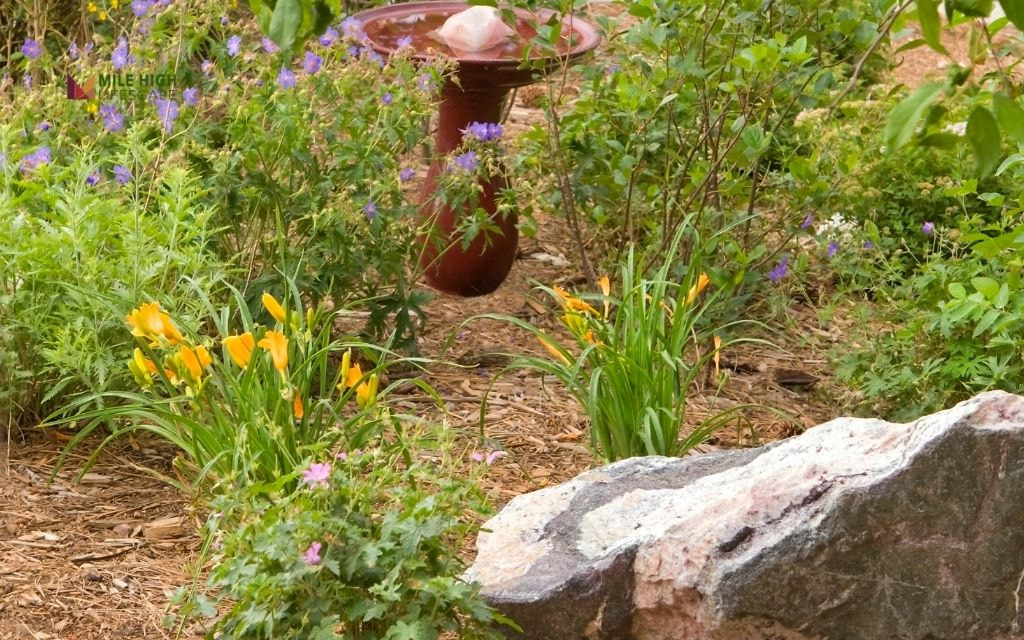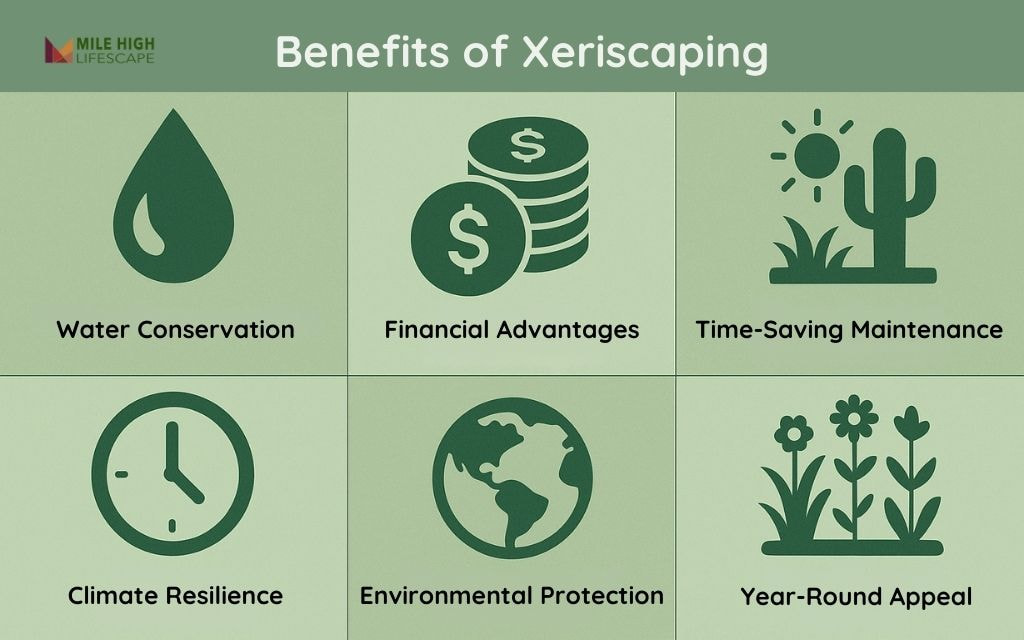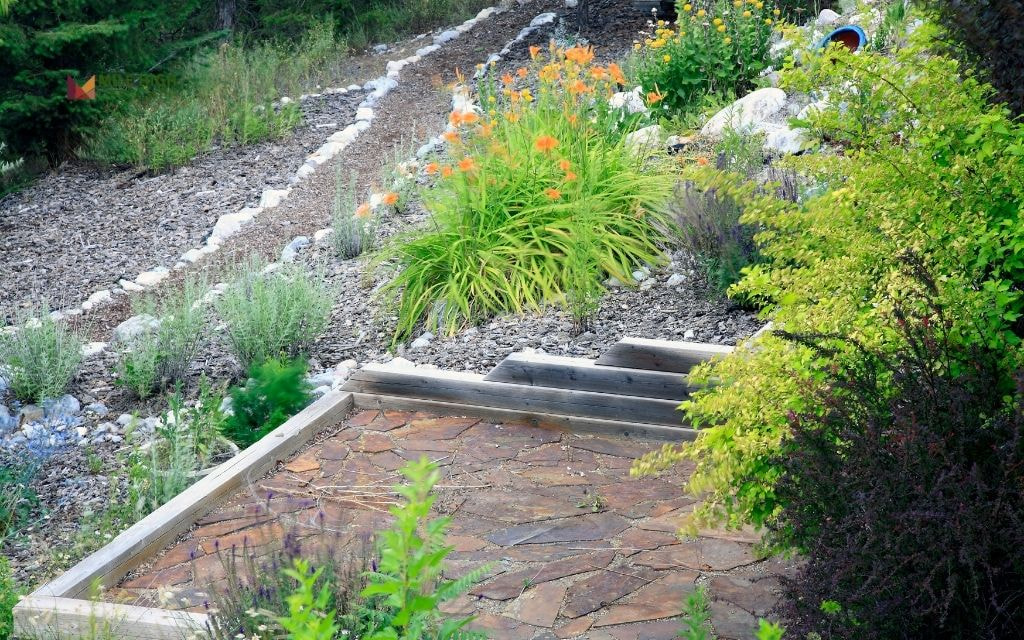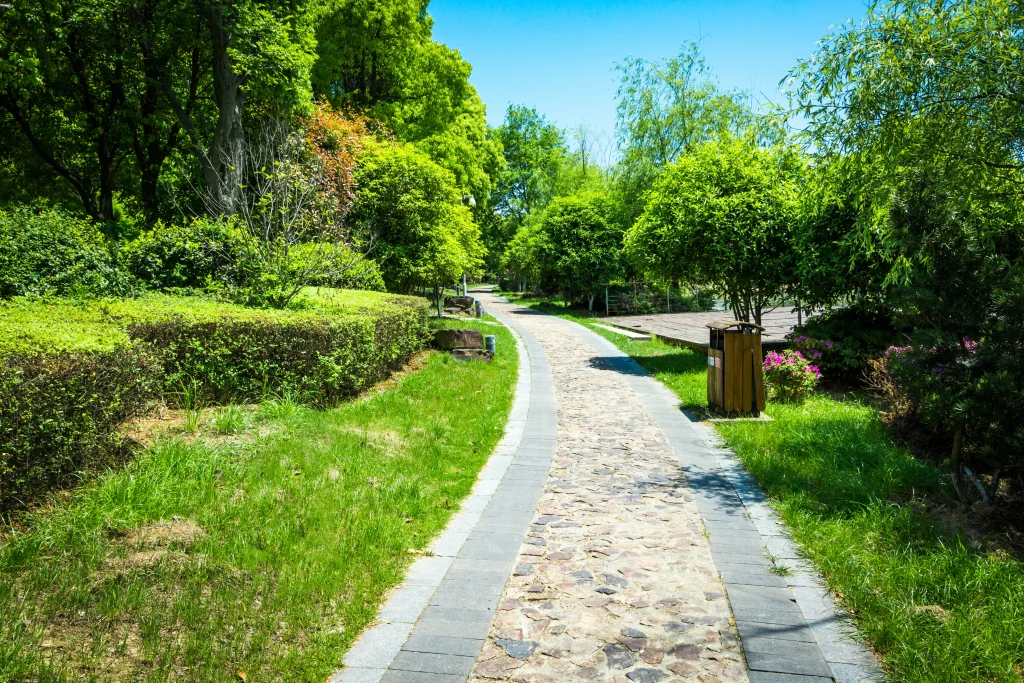In Denver’s semi-arid climate, water conservation isn’t just environmentally responsible – it’s economically essential. With rising water costs and frequent drought conditions, traditional green lawns demand unsustainable resources. Xeriscaping offers Denver homeowners a practical solution that works with our unique climate instead of against it.
As Denver’s landscape specialists at Mile High Lifescape, we’ve helped many homeowners transform their yards into water-efficient, beautiful spaces. Let’s explore what xeriscaping means, how it works in Colorado, and why it matters for your property.
What Is Xeriscape? Origins and Definition
Xeriscaping combines the Greek word “xeros” (dry) with “landscape.” Denver Water coined this term in the early 1980s during severe drought conditions to promote water-conscious landscaping practices throughout Colorado’s Front Range.
At its core, xeriscaping is landscape design that minimizes or eliminates the need for supplemental irrigation.
It’s not simply replacing grass with rocks (see zeroscape vs xeriscape). Instead, xeriscaping creates sustainable landscapes through thoughtful plant selection, efficient irrigation systems, and proper soil management.
True xeriscaping incorporates strategic design principles to create vibrant, colorful, and textured landscapes that thrive in Denver’s climate while using significantly less water than conventional lawns.

Benefits of Xeriscaping for Denver Properties
Xeriscaping delivers substantial advantages for Colorado homeowners beyond simple water conservation. Let’s explore these benefits of xeriscaping in detail:
Significant Water Conservation
Water savings of 50-75%: Traditional lawns require approximately 18 gallons of water per square foot annually. Convert 1,000 square feet of traditional lawn to xeriscape and save approximately 60 gallons of water daily – over 20,000 gallons yearly.
After establishment, most xeriscape plants need minimal supplemental irrigation, relying instead on natural rainfall patterns.
Financial Advantages
Denver Water estimates homeowners can reduce outdoor water costs by up to 60% with proper xeriscaping. For the average Denver home, this translates to $200-600 annual savings, increasing as water rates continue to rise.
Additionally, xeriscaping eliminates costs for fertilizers, pesticides, and gas for lawn equipment, saving another $150-300 annually.
Time-Saving Maintenance
Traditional lawns demand weekly mowing during the growing season, plus regular edging, aerating, and fertilizing.
Xeriscapes require occasional pruning, minimal weeding (thanks to proper mulching), and seasonal cleanup. Most homeowners report cutting their yard work time by 50-75%, freeing up summer weekends for Colorado’s recreational opportunities.

Climate Resilience
Colorado experiences periodic drought cycles that stress conventional landscapes. Native and adapted species, including Colorado xeriscape plants like Penstemons or Yarrow, have evolved natural mechanisms to withstand dry conditions without showing stress or damage. During water restrictions, xeriscaped properties maintain their appearance while traditional lawns often turn brown and deteriorate.
Environmental Protection
Traditional lawns generate multiple environmental concerns:
- Fertilizer runoff contributes to water pollution in local watersheds
- Gas-powered lawn equipment produces significant air pollution
- Pesticides harm beneficial insects and can contaminate soil
- Excessive water usage strains Colorado’s limited water resources
Xeriscaping addresses these issues through reduced inputs and sustainable practices, protecting Denver’s local ecosystems.
Year-Round Appeal
Unlike lawns that turn brown in winter, strategic plant selection in xeriscapes provides texture, color, and structure through all seasons.
Consider ornamental grasses that offer winter interest, early-blooming native perennials, and plants with distinctive seed heads or bark features. This creates landscapes that remain visually appealing throughout Colorado’s distinct seasons.
Disadvantages and Concerns of Xeriscaping
Despite its benefits, misconceptions about xeriscaping persist. Here’s how we address these concerns with Denver clients:
| Concern | Solution |
| “It looks barren and dry” | Implement layered designs with year-round color from native flowering perennials like Penstemons, Blanket Flower, and Russian Sage |
| “Installation costs too much” | Utilize Denver Water rebates (up to $3 per square foot) and phase implementation over multiple seasons |
| “Too rocky and unwelcoming” | Incorporate natural stone formations with softer elements like ornamental grasses and groundcovers |
| “I’ll miss my green lawn” | Retain small, strategic turf areas in high-use zones while converting peripheral areas to xeriscape |
The most successful xeriscapes strike a balance between water conservation and aesthetic appeal – they’re designed to harmonize with both the local environment and homeowner preferences.

Traditional Landscaping vs. Xeriscaping: Key Differences
Understanding how xeriscaping differs from conventional landscaping helps clarify its advantages:
| Feature | Traditional Landscaping | Xeriscape Landscaping |
| Water Requirements | 30+ inches annually (Denver receives ~14 inches) | Minimal supplemental irrigation after establishment |
| Plant Selection | Non-native species requiring intensive care | Native and drought-adapted plants suited to local conditions |
| Maintenance | Weekly mowing, regular fertilization, frequent watering | Occasional pruning, minimal weeding, reduced inputs |
| Design Approach | Uniform appearance prioritizing grass | Varied textures, heights, and seasonal interest |
| Long-term Costs | High ongoing expenses for water, chemicals, equipment | Higher initial investment with lower lifetime costs |
| Environmental Impact | Resource-intensive with chemical dependencies | Resource-efficient with ecological benefits |
Xeriscaping doesn’t mean eliminating grass entirely – it’s about thoughtful placement and appropriate scale. Many successful xeriscapes incorporate small areas of drought-resistant turf where it serves a functional purpose.
The 7 Core Principles of Xeriscaping for Denver Yards
Professional xeriscaping follows 7 established principles adapted specifically for Denver’s unique conditions:
- Planning and Design: Create hydrozones that group plants with similar water requirements. In Denver, consider winter sun exposure and wind patterns when planning. Explore xeriscape landscaping ideas that showcase native beauty and year-round structure.
- Soil Improvement: Enhance Denver’s clay soils with organic matter to improve drainage and water retention. Proper soil preparation prevents compaction issues common in our region.
- Efficient Irrigation: Install drip systems that deliver water directly to plant roots, reducing evaporation. Zone irrigation based on plant needs and exposure conditions.
- Appropriate Plant Selection: Choose Colorado natives and adapted plants suited to our climate extremes. Consider Plant Select® recommendations specifically tested for Front Range conditions.
- Mulching: Apply 3-4 inches of appropriate mulch to reduce evaporation and suppress weeds. In Denver, use heavier mulches on slopes to prevent erosion during sudden downpours.
- Limited Turf Areas: Replace water-intensive Kentucky bluegrass with drought-resistant alternatives like buffalograss or blue grama where turf is desired.
- Appropriate Maintenance: Develop seasonal maintenance routines focused on soil health and plant vigor rather than artificial appearance.
Learn how to xeriscape using these fundamental principles adapted for Colorado yards.
Visual Elements of Successful Xeriscapes
Effective xeriscape design templates need to use these design elements:
- Structural layers: Combine trees, shrubs, perennials, and groundcovers to create visual interest and habitat diversity.
- Seasonal color progression: Select plants that provide color throughout growing seasons – spring bulbs, summer perennials, fall foliage, and winter textures.
- Focal points: Incorporate distinctive landscape elements like specimen plants, boulder groupings, or ornamental grasses as visual anchors.
- Naturalistic groupings: Plant in irregular clusters rather than formal rows to mimic natural plant communities and reduce water needs.
- Functional hardscaping: Integrate permeable pathways, patios, and sitting areas that complement plantings while reducing total irrigated space.
The aesthetics of xeriscaping extend beyond drought tolerance – when properly designed, these landscapes showcase Colorado’s natural beauty while functioning efficiently.

How Much Does Xeriscape Costs and Its Long-Term Value
Initial investment in xeriscaping typically ranges from $5-$15 per square foot, depending on design complexity, plant selections, and hardscaping elements. This represents:
- Professional design: $500-2,000 depending on property size
- Lawn removal: $1-3 per square foot
- Soil preparation: $1-2 per square foot
- Plant materials: $3-7 per square foot
- Irrigation installation: $1-4 per square foot
While xeriscape costs exceed traditional landscaping, calculate the return on investment:
- Water savings: $200-600 annually for typical Denver properties
- Reduced maintenance costs: $500-1,500 annually in lawn care services
- Rebate programs: Up to $3 per square foot through Denver Water
- Property value increase: 5-15% according to regional real estate analyses
Most Denver homeowners recover xeriscaping investments within 3-7 years through reduced water bills and maintenance costs alone.
Conclusion
Xeriscaping is a practical water conservation strategy perfectly suited to Denver’s climate. As water becomes precious in the West, xeriscaped properties demonstrate responsible resource management while creating beautiful, functional outdoor spaces.
At Mile High Lifescape, we design xeriscapes that balance environmental responsibility with aesthetic appeal, proving that water conservation doesn’t require sacrificing beauty or enjoyment of your outdoor spaces.
Ready to explore xeriscape landscaping near Denver?
Contact our landscape specialists at (303) 877-9091 or hello@milehighlifescape.com for free estimates tailored to your specific site conditions and preferences.
Frequently Asked Questions (FAQs)
What’s the difference between xeriscape and zeroscape?
Xeriscaping involves using drought-tolerant plants and efficient irrigation systems to create a water-wise landscape. Zeroscape describes a landscape almost entirely devoid of plants, relying instead on gravel and stone. Xeriscaping offers a more vibrant, plant-rich approach while still conserving water.
How much does it cost to xeriscape a yard?
Professional xeriscaping costs $5-15 per square foot, averaging about $17,000 for a 1,200-square-foot yard and $6,000 for a 500-square-foot yard. DIY approaches can reduce costs significantly. Denver Water offers rebates up to $3 per square foot for turf replacement.
Will xeriscaping increase or decrease home value?
Xeriscaping typically increases home value in the Denver market. While some buyers prefer traditional lawns, properly designed xeriscapes offer enhanced curb appeal, reduced maintenance costs, and sustainability features increasingly valued by Colorado homebuyers.
Do you need to remove grass before xeriscaping?
Yes, removing existing turf is essential for successful xeriscaping. This eliminates competition for resources and prevents grass from infiltrating new plantings. Options include manual removal, solarization, sheet mulching, or using specialized equipment depending on lawn size and timeline.
What are the best xeriscape plants for Colorado?
Excellent xeriscape plants for Colorado include:
– Trees: Thornless Honeylocust, Kentucky Coffee Tree, Rocky Mountain Juniper
– Shrubs: Manzanita, Fernbush, Russian Sage, Rabbitbrush
– Perennials: Penstemon, Yarrow, Hyssop, Gaillardia, Evening Primrose
– Grasses: Blue Grama, Little Bluestem, Prairie Dropseed, Feather Reed Grass
– Groundcovers: Creeping Thyme, Sulfur Flower, Pussytoes
Select plants appropriate for your specific site conditions including sun exposure, soil type, and available space.
